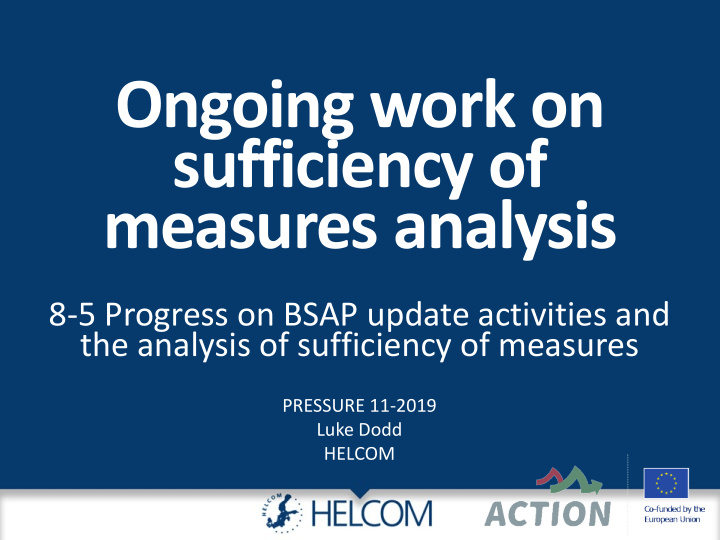



Ongoing work on sufficiency of measures analysis 8-5 Progress on BSAP update activities and the analysis of sufficiency of measures PRESSURE 11-2019 Luke Dodd HELCOM
Business-as-usual (BAU) stateand sufficiency of measures GES GES gap Environmental status Example business-as- Possible BAU states usual (BAU) state Measures Change in human activities 2016 20XX (end year of BAU) Time
Components of the sufficiency of measures (SOM) analysis Step 5 Projected development GES of activity by 20XX GES gap Steps Steps 7 & 8 1 & 2 Sub Step GES Activity Step 3 4 Step 1 Need for Comparison new Step 4 Pressure BAU vs. GES State in measures Step Step Existing year 4 6 20XX measures (BAU) (grouped) Step 4
Features of SOM analysis • Supports the BSAP update by assessing how far we are from achieving GES with existing measures • Provides supporting information to identify need for potential new measures • First time SOM assessment is done in this extent • Same approach applied across all topics to ensure comparability and coherence (birds, mammals, fish, marine litter, underwater noise, input of nutrients, etc.)
Main components in SOM analysis using expert elicitation 1. Linking activities to pressures (step 3) 2. Effects of measures on pressures (step 4) 3. Linking pressures with state components (step 6) • Information from scientific literature and expert elicitation to allow for comprehensive inclusion of measures, pressures and state components
Components of the sufficiency of measures (SOM) analysis Step 5 Projected development GES of activity by 20XX GES gap Steps Steps 7 & 8 1 & 2 Sub Step GES Activity Step 3 4 Step 1 Need for Comparison new Step 4 Pressure BAU vs. GES State in measures Step Step Existing year 4 6 20XX measures (BAU) (grouped) Step 4
Components of the sufficiency of measures (SOM) analysis Step 5 Projected development GES of activity by 20XX GES gap Steps Steps 7 & 8 1 & 2 Sub Step GES Activity Step 3 4 Step 1 Need for Comparison new Step 4 Pressure BAU vs. GES State in measures Step Step Existing year 4 6 20XX measures (BAU) (grouped) Step 4
Components of the sufficiency of measures (SOM) analysis Step 5 Projected development GES of activity by 20XX GES gap Steps Steps 7 & 8 1 & 2 Sub Step GES Activity Step 3 4 Step 1 Need for Comparison new Step 4 Pressure BAU vs. GES State in measures Step Step Existing year 4 6 20XX measures (BAU) (grouped) Step 4
Steps 4 and 6 in the SOM analysis • Step 4: Estimation of effects of measures – Estimate of the reduction in a specific pressure (in %) from a generalized measure • Step 6: Linking pressures with state components – Links between pressures and state components – Depending on the existence of GES threshold: a) Required pressure reduction (in %) to reach or maintain GES b) Change in the state component from a specific reduction in pressures (in %)
Steps 4 and 6 in the SOM analysis • Expert elicitations (workshops and surveys) • Literature, studies and models to complement and use as reference points • Discussed and supported by the SOM Platform 2-2019 meeting
Current status of work • Mammals (EG MAMA), birds (JWG BIRD), and hazardous substances SOM workshops implemented • Remaining workshops: – Fish, 4-6 November, Warsaw – Benthic habitats, 14 November, Helsinki • Online surveys: noise, litter, eutrophication
SOM hazardous substances workshop • Workshop objectives – Provide background information on the sufficiency of measures (SOM) analysis in the BSAP update – Describe the expert elicitation approach – Test and discuss the components and structure of the expert surveys – Gather valuable comments and feedback for finalizing the surveys • Notes from the workshop will be made avaliable soon
SOM hazardous substances Next steps • Secretariat will incorporate workshop proposals into the surveys • Updated surveys will be ready for distribution in November • Workshop concluded that all survey questions will likely not be possible to answer by one expert Proposal to distribute to workshop participants, EN Hazardous substances, and CPs would be requested to nominate additional experts to contribute to the survey
Document 8-12 Activity-Pressure data for loss and disturbance to the seabed • Based on the approach used in HOLAS II – Links percent contribution of activities to the two physical disturbance pressures • Document also presented to S&C 11 – Agreed to provide written comments by 6.11 to the Secretariat Proposal that a single consolidated national response is organized through State & Conservation contacts by the agreed date
Document 8-13 Activity-Pressure data for marine litter and underwater noise • Based on expert surveys • Litter Responses from FI, SE, DE, DK • In communication with PL, LV • • Noise Responses from SE, EE, PL, DE • In communication with DK •
Validation process Working mode alternatives 1. Forward expert input to the analysis for validation as they become ready 2. Consolidate all input related to Pressure WG and make it available at the same time. Note: consolidated input will be ready in December 2019 at the earliest Approval process alternatives 1. Correspondence 2. Online meeting
Recommend
More recommend